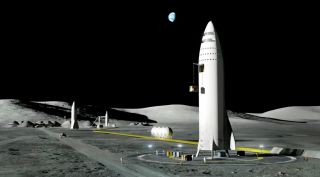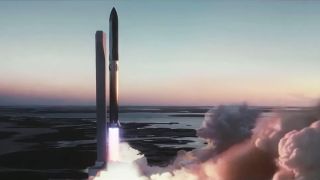Starship and Super Heavy – Space.com
Starship and Super Heavy are the biggest, most important pieces of Elon Musk’s grand plan for SpaceX, his private spaceflight company.
Musk has repeatedly stressed that he founded SpaceX back in 2002 primarily to help humanity colonize Mars. It’s vital that we become a multiplanet species, the billionaire entrepreneur has said, citing both a much-reduced probability of extinction and the thrill that meaningful space exploration will deliver to billions of people around the world.
SpaceX is now actively trying to turn this sci-fi dream into reality. The company is developing a 100-passenger spaceship called Starship and a giant rocket known as Super Heavy, which together constitute the transportation system that Musk thinks will bring Mars settlement within reach at long last.
“This is the fastest path to a self-sustaining city on Mars,” Musk said in September 2019, during a webcast update about the Starship-Super Heavy architecture.
Related: SpaceX’s Starship and Super Heavy Rocket in Pictures
The original vision
These updates have become a highly anticipated annual tradition; Musk has given one every September since 2016.
During that first presentation, he laid out the basic idea: A large spacecraft and a huge rocket, both of which will be completely and rapidly reusable. The rocket will launch the spacecraft into Earth orbit, then come back down to Earth for a vertical, propulsive landing.
The spaceship, meanwhile, will make its own way from Earth orbit to Mars (or the moon, or any other desired destination). The craft will touch down on such alien worlds and take off from them as well, without the need for any additional landing craft or ascent vehicles. (The separate rocket is needed just to get out of Earth’s substantial gravity well.)
Off-Earth refueling of the ship is therefore key to Musk’s vision. For example, spacecraft coming home from Mars or the moon will need to be topped up on those worlds, using locally produced propellant.
In 2016, Musk called this architecture the Interplanetary Transport System (ITS). The name was new, as the billionaire had previously referred to his envisioned concept (though much more vaguely) as the Mars Colonial Transporter.

The ITS architecture isn’t supposed to be Mars-specific; the system could help establish a base on the moon, Musk said.
(Image credit: SpaceX)
The ITS will stand 400 feet (122 meters) tall when stacked, Musk said back then. The rocket will contribute most of that height, measuring 254 feet (77 m) tall to the ship’s 162 feet (49 m). There will be some overlap of the two vehicles during stacking, which explains why the total height isn’t 416 feet.
Both vehicles will be powered by SpaceX’s next-generation Raptor engine, which is more powerful than the Merlin that propels the company’s Falcon 9 and Falcon Heavy rockets. The ITS ship will sport nine Raptors and the 40-foot-wide (12 m) booster will boast a whopping 42, allowing the rocket to produce 13,033 tons of thrust at liftoff — 3.6 times more than NASA’s Saturn V moon rocket was able to generate, Musk said. (For comparison, the Falcon 9 has nine first-stage engines and the Falcon Heavy has 27.)
Related: See Stunning Photos of SpaceX Falcon Heavy’s First Night Launch
And there won’t just be one ITS ship and booster. The ultimate plan involves sending 1,000 or more people-packed spaceships to Mars every 26 months, helping to establish a million-person city on the Red Planet within 50 to 100 years, Musk said. (Earth and Mars align favorably for interplanetary missions just once every 26 months.)
Musk did not lay out plans for building this city. That will happen organically as more and more people arrive on Mars, he said, comparing the ITS to the transcontinental railroad that helped open the American West to settlement from the East and Midwest in the 19th century.
And these pioneers won’t just be the super-rich, if all goes according to plan. The ITS’s reusability could eventually bring the price of a Mars trip down enough to make it affordable for large numbers of people, Musk said.
“The architecture allows for a cost per ticket of less than $200,000,” Musk said during the 2016 presentation. “We think that the cost of moving to Mars ultimately could drop below $100,000.”
This overall vision has held firm over the past three years, but Musk has repeatedly tweaked the design and the system’s name.
In 2017, for example, he announced that ITS was now the BFR, which stood for “Big Falcon Rocket” (or “Big F***ing Rocket;” SpaceX representatives have invoked both variants). The BFR was shorter, slimmer and less powerful than its design predecessor, measuring 348 feet (106 m) tall by 30 feet (9 m) wide when stacked and featuring “only” 31 Raptor engines on the booster and six on the spaceship.
But the biggest change concerned use of the spaceship-rocket duo. Musk announced that SpaceX eventually planned to employ the BFR for all of its spaceflight needs, from launching satellites to ferrying people to and from Mars to cleaning up space junk in Earth orbit. The Falcon 9 and Falcon Heavy therefore will be phased out over the long haul, as will both the crew and cargo variants of SpaceX’s Dragon capsule.
Expanding the BFR’s role in this manner will make the system much more affordable for SpaceX to develop and manufacture, Musk said at the time.
“If we can do that, then all the resources that are used for Falcon 9, Heavy and Dragon can be applied to this system. That’s really fundamental,” he said in September 2017. “We believe that we can do this with the revenue we receive for launching satellites and for servicing the space station.”
Related: See the Evolution of SpaceX’s Rockets in Pictures
The BFR design then experienced a growth spurt that nearly took the system back to its original height. In September 2018, Musk told us that the rocket-spaceship duo will now stand 387 feet (118 m) tall when stacked. The BFR ship will also sport seven Raptors instead of six, Musk added, and the vehicle will now sport four movable fins — two near its nose and two bigger ones near the tail.
These fins will help the ship maneuver its way to safe landings on worlds with significant atmospheres, such as Mars and Earth. The two rear fins will also serve as landing pads, as will a leg that’s stylized to look like a fin, Musk said.
The ship’s overall aesthetic will therefore resemble that of the rocket used by the cartoon character Tintin in the 1954 adventure “Explorers on the Moon.” And that tidbit pleases Musk.
“I love the Tintin rocket design, so I kind of wanted to bias it towards that,” he said at the time. “If in doubt, go with Tintin.”
Other big news came out of the September 2018 update as well: SpaceX had signed its first BFR customer. Japanese billionaire Yusaku Maezawa booked a round-the-moon trip on the BFR, with a target launch date of 2023. Maezawa said he planned to take a handful of artists with him on the mission, which he calls DearMoon. Neither SpaceX nor Maezawa has revealed how much the flight will cost.
Related: How SpaceX’s 1st Passenger Flight Around the Moon with Yusaku Maezawa Will Work
Two months later, the BFR was no more: Musk told us that the system will now be called Starship. That will also be the spaceship’s name, whereas the huge rocket will be called Super Heavy.
At that point, SpaceX still planned to build the Starship vehicle out of carbon fiber. But in January 2019, Musk announced that he was switching to stainless steel. Steel is a bit heavier than carbon fiber but has great thermal properties and is far, far cheaper, Musk said. He has since called the material switch the best design decision yet made on the ITS/BFR/Starship project.
In May 2019, Musk said the current plan calls for six Raptors on the Starship vehicle rather than seven. And a few months later, he tweeted that Super Heavy will now sport 35 Raptors instead of 31.
That brings us to the latest design update, which Musk presented on Sept. 28, 2019, from SpaceX’s South Texas facility, near the tiny village of Boca Chica. The billionaire didn’t announce any huge changes, though there was some more engine news: Super Heavy will now have space for 37 Raptors, though not all of those slots will be filled on every flight. Each mission will probably require at least 24 Raptors on the booster, Musk said.
Musk had previously estimated the total development cost of the Starship project to be between $2 billion and $10 billion. On Sept. 28, he said he now believes the price tag for SpaceX will be toward the lower end of that range — “probably closer to two or three [billion] than it is to 10,” Musk told CNN Business during an interview shortly after the design update.

SpaceX’s Super Heavy rocket booster launches the Starship interplanetary spacecraft in this still from a SpaceX animation.
(Image credit: SpaceX)
Test flights underway
The September 2019 update was more dramatic than those of previous years, because Musk had an eye-catching visual aid nearby — a 165-foot-tall (50 m) Starship prototype called the Mk1.
SpaceX had already built and flown a Starship prototype — a stubby, one-engine vehicle dubbed Starhopper that aced two brief, untethered test flights at Boca Chica before being retired in late August.
But the Mk1 is a big step forward. It’s the first full-size Starship test vehicle, and it’s scheduled to fly high soon. During his presentation, Musk said that SpaceX aims to fly the three-engine Mk1 on an uncrewed test mission in October or November that will take the vehicle to an altitude of about 12 miles (20 km).
SpaceX is building a similar vehicle called the Mk2 at its Florida facilities, reasoning that some intracompany competition will improve the design of the final Starship vehicle. And more iterations of the spaceship should hit the skies in short order as well.
During the September 2019 presentation, Musk said that SpaceX wants to launch an orbital test flight with Starship in less than six months — so, by early spring of 2020. The vehicle that flies that landmark uncrewed mission will likely be the Starship Mk4 or Mk5, he said.
Related: Why NASA’s Annoyed About Elon Musk’s Giant Rocket
If the development and testing campaigns continue to go well, Musk added, people could start flying aboard Starship for the first time next year. (The first operational Starship missions, by the way, could happen as soon as 2021, company representatives have said. Those early commercial flights will be uncrewed and probably loft communications satellites.)
There’s a fair amount of work to do in the interim, of course, and it’s not all about optimizing fin design. For example, there’s the not-insignificant issue of keeping Starship’s passengers happy and healthy during their flights to the moon, Mars and beyond.
We know little about Starship’s life-support system. But Musk did say during the September 2019 update that he envisions a “regenerative” system, which recycles water vapor and carbon dioxide, processing this latter gas to provide oxygen. And he doesn’t think implementing this tech will be all that difficult.
“I don’t think it’s actually superhard to do that,” he said. “Relative to the spacecraft itself, the life-support system is pretty straightforward.”
Musk is famous for his “aspirational” timelines, so the above target dates are far from set in stone. But big things are definitely happening on the Starship project; stay tuned!
Additional resources:
Mike Wall’s book about the search for alien life, “Out There” (Grand Central Publishing, 2018; illustrated by Karl Tate), is out now. Follow him on Twitter @michaeldwall.






